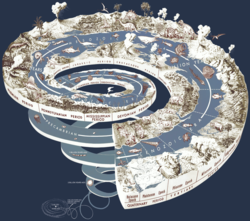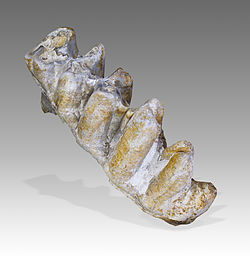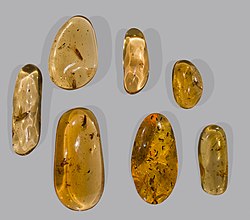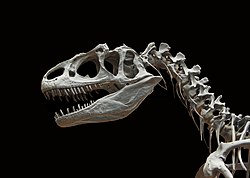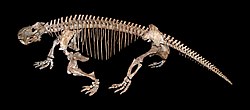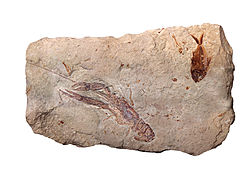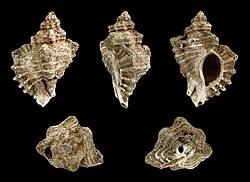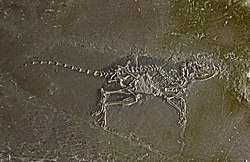Portal:Paleontology/Selected picture
Selected pictures
Image credit: Joseph Graham, William Newman, and John Stacy for the United States Geological Survey
Upload credit: Mwtoews

A skeleton of .
Photo credit: Didier Descouens

An specimen of the brachiopod Liospiriferina rostrata. Brachiopods filtered plankton, using a specialized, spiral-shaped organ called a lophophore. This specimen is about 35 × 30 mm in size and dates back to the Pliensbachian age of the Jurassic period in France.
Photo credit: Didier Descouens
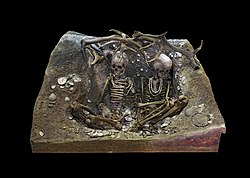
Two skeletons of women between 25 and 35 years of age preserved in the Tomb of Téviec. The tomb is dated to the Mesolithic between 6,740 and 5,680 years ago. They died a violent death, with several head injuries and impacts of arrows. The two bodies were buried with great care in a pit half in the basement rock (underlying or country rock) and half in the kitchen debris that covered them. The tomb is protected by antlers. The grave goods include flint and bone (mainly wild boar) offerings and funeral jewelry which is made of marine shells drilled and assembled into necklaces, bracelets and ankle ring. Some of the bone objects have engraved lines. The tomb was recovered in 1938 and restored in 2010.
Photo credit: Didier Descouens
Photo credit: Didier Descouens

A tooth of
Photo credit: Didier Descouens

Skull from one of the women preserved in the
Photo credit: Didier Descouens

A skeleton of
Photo credit: Didier Descouens

A stromatolite collected from the 3,600- to 3,200-million-year-old Paleoarchean Strelley Pool Chert of Western Australia, Australia. Stromatolites are formed over the years by mats (1–10 mm in thickness) of microorganisms (cyanobacteria among others) found in shallow, mainly marine waters. The microorganisms precipitate mineral particles, which makes the mat thicken, but only the upper part survives. Most stromatolites display characteristically layered structures. Only the layers are visible to the naked eye.
Photo credit: Didier Descouens
Photo credit: Didier Descouens
Photo credit: Didier Descouens
Photo credit: José Braga and Didier Descouens

A shell trumpet made of the conch species Charonia lampas dating back 10,000 to 17,000 years ago to the Magdalenian stage of the Upper Paleolithic. The specimen is 31 × 18 × 18 cm in size and cataloged by the Muséum of Toulouse as MHNT.PRE.2010.0.1.2. It was discovered in 1931 during field work undertaken by Henri Begouen of the University of Toulouse and J. Townsend Russell of the Smithsonian Institution in the Marsoulas cave of Marsoulas, Haute-Garonne, France.
Photo credit: Didier Descouens

Cast of the skull and neck vertebrae of a .
Photo credit: Jebulon
Photo credit: Brocken Inaglory

The mounted lectotype skeleton of the Late Jurassic stegosaur Kentrosaurus aethiopicus in the Museum für Naturkunde of Berlin, Germany. The specimen was a partial 4.5-m-long individual excavated from the "St" quarry at Kindope, Tendaguru, Tanzania.
Photo credit: H. Zell
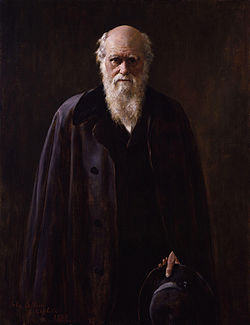
An 1883 copy of an 1881 portrait of
Art credit: John Collier
Upload credit: User:Dcoetzee

A specimen of copal with insect inclusions. The piece of copal measures around four centimeters deep and the insects are trapped from 0.5 to 2 centimeters deep within it. The bubbles around some of the insects indicate that they were alive and breathing when they were trapped inside.
Photo credit: Brocken Inaglory
Upload credit: Mbz1
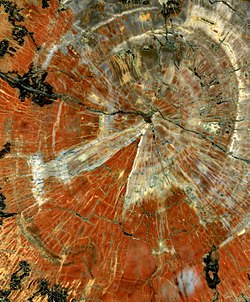
The middle of a polished 15.34 cm × 18.04 cm slice of a
Photo credit: Michael Gäbler
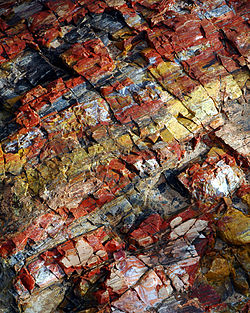
Close up image of petrified wood from Canyonlands National Park in Utah, USA.
Photo credit: Jim Gordon

Various views of a shell of the Pliocene snail species Petaloconchus intortus from Baschi, Italy. The specimen is 2.9 cm long.
Photo credit: H. Zell
Photo credit: H. Zell
Photo credit: H. Zell
Photo credit: User:Mario modesto
Photo credit: H. Zell

An ant preserved in a small, roughly 1.5 cm by 2 cm piece of Colombian amber.
Photo credit: Brocken Inaglory
Artist credit: Mariana Ruiz
Photo credit: H. Zell

A fossil of a calymenid trilobite.
Photo credit: Thomas Bresson

The top image is a nodule containing a
Photo credit: Thomas Bresson
Photo credit: Didier Descouens

Fossil of a trilobite in the genus
Photo credit: Pierre Selim

